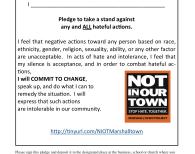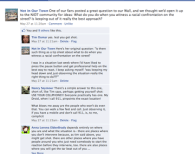Online Professional Development Opportunities for Educators
Create a Plan to End Bullying and Intolerance in Your School and Community
Not In Our School: Strategies to Address Bullying and Intolerance by Creating Safe, Inclusive, and Accepting Schools, a 2-unit online course offered through the University of San Diego, gives educators and administrators tools for preventing and addressing bullying, and supporting a positive, identity-safe school climate.
This course can be taken individually or as part of the University of San Diego Bullying Prevention in Our Schools Certificate program.
Instructor: Becki Cohn-Vargas, Ed.D., Not In Our School Director
intolerance

Marshalltown, IA residents have been emptying their shopping bags to find invitations to join the stand against hate.
In late July, the NIOT Marshalltown group printed pledge forms and inserted them as bag stuffers at various local stores. By signing the form, Marshalltown community members would pledge to "take a stand against any and ALL hateful actions," reject discriminatory actions, speak up in the face of hateful actions and commit to change.
Residents were then encouraged to return the signed pledge to the business, school or church from which they originally received the slip. The Times-Republican will then print a free ad listing the names of the pledged, intending to show the community-wide support of the movement against hate and bullying.
Meanwhile, Marshalltown welcomed President Barack Obama Tuesday afternoon. As part of his three-day campaign of Iowa, Obama spoke in Miller Middle School's gym.

From ColorLines: Read article, "Hate Speech Flourishes Online"
Being an upstander is not easy. Just ask J. Ryan Leach, a student at the University of Virginia, who has been a rare voice in online forums to speak up for tolerance. In his hometown of Mechanicsville, VA, crime stories in the news attract racist comments.

For Black History Month, we share this video, "Profiling Kevin," featuring a young man whose passion for racial and social justice leads him to engage his teachers and classmates about issues of diversity and equality in his school and community. Standing in a classroom at Palo Alto High School, 16-year-old Kevin tells his classmates, "We need to ... take a bite of the apple of knowledge and realize where we stand and where we need to go."

You're walking down the street, and witness an act of racism. How do you respond?
One of our Not In Our Town Facebook fans posted this question to our Wall, and an honest, thoughtful conversation followed.
Here are highlights from the discussion -- read the full post and share your thoughts on the NIOT Facebook page.
"I get involved if I think I can do some good to dissolve the situation. If I think someone, including myself, could get hurt or violent, I call the cops. Silence is usually not an option." (Briana)
Last Tuesday, November 4, 2008, the United States elected its first African-American president: Barack Obama. While many people around the world celebrated the historic moment, other responses took the form of ugly race-related incidents, sending a reminder that this election does not mark the end of the fight against intolerance and hate.
TORRANCE, CA: This past Sunday morning, a few Obama supporters in Torrance awoke to an ugly message: their houses, cars, campaign signs, and trees where they had displayed Obama signs and stickers were defaced by hate graffiti. The vandalism included spray-painted swastikas, “Go Back to Africa,” “N****R,” and “Hitler.” Police are investigating the acts of vandalism as hate crimes. One resident, who found four swastikas painted on her car and her “Yes We Did!” banner torn down, said that many of her McCain-supporting neighbors had expressed their concern and support for her, saying, “This shouldn’t happen ever, and it was a hate crime.”
Read more: